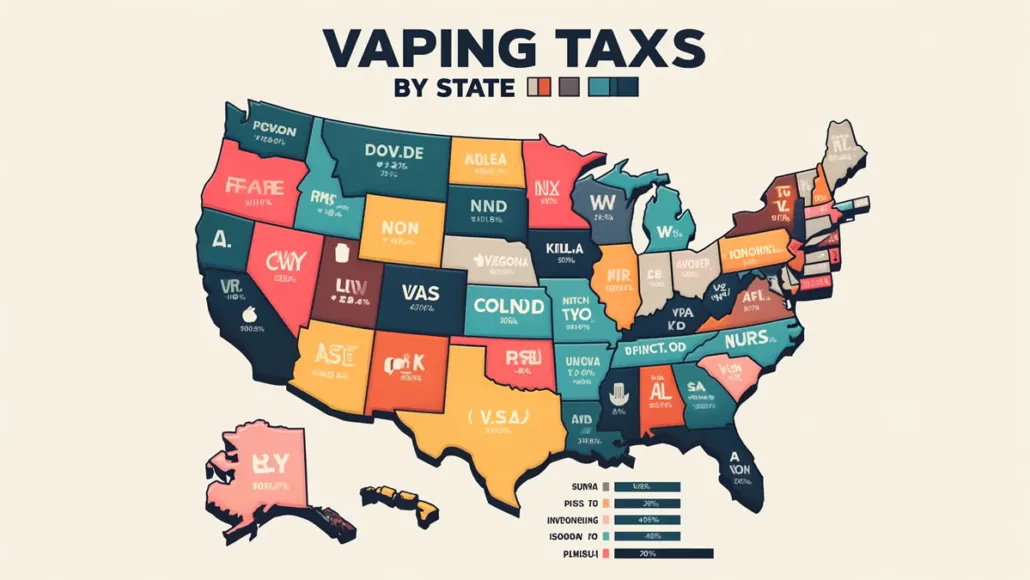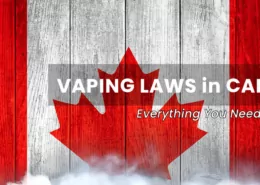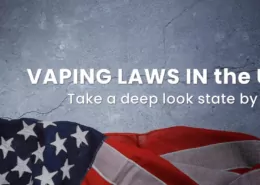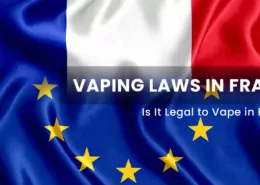Vaping Taxes by State in the United States 2024
Vaping has become a popular alternative to traditional smoking in recent years, but with its growing popularity comes increased regulation and taxes. As vaping taxes vary from state to state, it’s essential to understand the specific regulations and taxes in each state in the United States.
Let’s take a deep dive into the vaping taxes by state in the United States and provide a comprehensive guide to help you navigate the regulations and taxes for your state.
UNDERSTANDING VAPING TAXES
As vaping continues to increase in popularity, it has become a common target for governments in search of tax revenue. The reason for this is that vapor products are frequently purchased by smokers and former smokers, causing tax authorities to assume that the money spent on e-cigarettes is money not being spent on traditional tobacco products. Governments have relied on tobacco products as a source of income for many decades.
The Federal vape taxes in USA
In the United States, vaping products are currently exempt from federal taxation. However, this may change in the near future as proposals for taxing these products have been introduced in Congress. Despite the attempts, none of these bills have yet gained enough support to become law.
The Debate on Taxing Vaping Devices and E-Liquids
Whether or not vaping devices and e-liquids should be taxed like tobacco products is a matter of ongoing debate. Governments see the shift of smokers away from tobacco and understand that the lost revenue must be compensated. With its appearance similar to smoking and substantial public health opposition, vaping has become an attractive target for politicians, particularly because they can justify the tax with a variety of questionable health claims.

VAPING TAXES BY STATE 2024
In this section, we will take a look at the vaping taxes by state in the United States and provide a detailed breakdown of the regulations and taxes for each state.
Note: The taxes of OPEN and CLOSED vaping products maybe different in some states.
- Open Vape is a type of vaporizer that allows the user to refill the liquid and has more freedom in voltage and nicotine levels..
- Closed Vape is a type of vaporizer that uses pre-filled cartridges or tanks that are not refillable. Closed Vape systems are typically more convenient and easier to use than open systems.
Alabama
As of early 2024, Alabama does not have a statewide vaping tax.
Alaska
Alaska does not impose a statewide vaping tax, but several municipalities have implemented their own taxes:
- Juneau Borough, NW Arctic Borough, and Petersburg Borough: 45% wholesale tax on nicotine-containing products
- Anchorage Borough: 55% wholesale tax on vaping products
- Matanuska-Susitna Borough: 55% wholesale tax on vaping products
Arizona
As of early 2024, Arizona does not have a statewide vaping tax.
Arkansas
As of early 2024, Arkansas does not have a statewide vaping tax.
California
California imposes a two-tiered tax on vaping products:
- Wholesale tax: Set annually by the Board of Equalization, currently 56.32% of the wholesale cost for nicotine-containing products (as of July 1, 2023)
- Example: If a vaping device has a wholesale cost of $100, the wholesale tax would be $56.32.
- Retail tax: 12.5% on all nicotine-containing vaping products, including those purchased online from out-of-state retailers (effective July 1, 2022)
- Example: If a vaping device has a retail price of $200, the retail tax would be $25.
Colorado
Colorado has a graduated tax on nicotine-containing vapor products, including bottled e-liquid:
- 50% of manufacturer’s list price as of 2023, increasing to 56% in 2024 and 62% in 2027
- Example: If a vaping product has a manufacturer’s list price of $100, the tax would be $50 in 2023, $56 in 2024, and $62 in 2027.
- Products with FDA Modified Risk Tobacco Product (MRTP) designation receive a 50% tax reduction
Connecticut
Connecticut has a two-tiered tax on nicotine-containing vape products:
- Closed-system products (pods, cartridges, cigalikes): $0.40 per milliliter of e-liquid
- Example: A pod containing 2 milliliters of e-liquid would have a tax of $0.80.
- Open-system products (bottled e-liquid and devices): 10% wholesale tax
- Example: If a bottled e-liquid has a wholesale price of $50, the tax would be $5.
Delaware
Delaware imposes a $0.05 per milliliter tax on nicotine-containing e-liquid.
- Example: A 30-milliliter bottle of nicotine-containing e-liquid would have a tax of $1.50.
District of Columbia
The District of Columbia classifies vapes as “other tobacco products” and imposes a tax based on the wholesale price, indexed to the wholesale price of cigarettes. The current tax rate is 91% of the wholesale cost for devices and nicotine-containing e-liquid.
- Example: If a vaping device has a wholesale cost of $100, the tax would be $91.
Florida
As of early 2024, Florida does not have a statewide vaping tax.
Georgia
Georgia has a two-tiered tax on vaping products, applying to both nicotine-containing and nicotine-free products:
- Closed-system products (pods, cartridges, cigalikes): $0.05 per milliliter of e-liquid
- Example: A pod containing 2 milliliters of e-liquid would have a tax of $0.10.
- Open-system products (bottled e-liquid and devices): 7% wholesale tax
- Example: If a bottled e-liquid has a wholesale price of $50, the tax would be $3.50.
Hawaii
Hawaii imposes a 70% wholesale tax on all vaping products.
- Example: If a vaping device has a wholesale cost of $100, the tax would be $70.
Idaho
As of early 2024, Idaho does not have a statewide vaping tax.
Illinois
Illinois imposes a 15% wholesale tax on all vaping products, including those with and without nicotine.
- Example: If a vaping device has a wholesale cost of $100, the tax would be $15. Additionally:
- Chicago: $1.50 per unit tax on nicotine-containing products, plus $1.20 per milliliter tax on e-liquid
- Example: A pod containing 2 milliliters of nicotine-containing e-liquid would have a tax of $3.90 ($1.50 per unit + $2.40 per milliliter).
- Cook County: $0.20 per milliliter tax on nicotine-containing products
- Example: A pod containing 2 milliliters of nicotine-containing e-liquid would have a tax of $0.40.
Indiana
Indiana has a 15% retail tax on all vaping product sales, with or without nicotine.
- Example: If a vaping device has a retail price of $100, the tax would be $15.
Iowa
As of early 2024, Iowa does not have a statewide vaping tax.
Kansas
Kansas imposes a $0.05 per milliliter tax on all e-liquid, with or without nicotine.
- Example: A 30-milliliter bottle of e-liquid would have a tax of $1.50.
Kentucky
Kentucky has a two-tiered tax on vaping products, applying to both nicotine-containing and nicotine-free products:
- Bottled e-liquid and open-system devices: 15% wholesale tax
- Example: If a bottled e-liquid has a wholesale price of $50, the tax would be $7.50.
- Prefilled pods and cartridges: $1.50 per unit tax
- Example: A pack of 4 pods would have a tax of $6.
Louisiana
Louisiana imposes a $0.15 per milliliter tax on nicotine-containing e-liquid.
- Example: A 30-milliliter bottle of nicotine-containing e-liquid would have a tax of $4.50.
Maine
Maine has a 43% wholesale tax on all vaping products, with or without nicotine.
- Example: If a vaping device has a wholesale cost of $100, the tax would be $43.
Maryland
Maryland has a two-tiered tax on vaping products:
- Open-system products (including nicotine-containing e-liquid): 6% retail tax
- Example: If a bottled e-liquid has a retail price of $50, the tax would be $3.
- Closed-system products (pods, cartridges, disposables) with nicotine-containing e-liquid under 5 milliliters: 60% tax
- Example: A pod containing 2 milliliters of nicotine-containing e-liquid would have a tax of $1.20 (assuming a wholesale price of $2).
- Montgomery County: Additional 30% wholesale tax on all vaping products, including devices sold without liquid
- Example: If a vaping device has a wholesale cost of $100, the additional tax would be $30.
Massachusetts
Massachusetts imposes a 75% wholesale tax on all vaping products, with or without nicotine.
- Example: If a vaping device has a wholesale cost of $100, the tax would be $75. Consumers must provide proof that their vaping products have been taxed, or they may face seizure and fines of $5,000 for the first offense and $25,000 for subsequent offenses.
Michigan
As of early 2024, Michigan does not have a statewide vaping tax.
Minnesota
Minnesota imposes a 95% wholesale tax on finished vaping products containing nicotine (cigalikes, pod vapes, bottled e-liquid) transported from out of state. For bottled e-liquid produced in Minnesota, only the nicotine itself is taxed.
- Example: If a vaping device has a wholesale cost of $100 and is transported from out of state, the tax would be $95.
Mississippi
As of early 2024, Mississippi does not have a statewide vaping tax.
Missouri
As of early 2024, Missouri does not have a statewide vaping tax.
Montana
As of early 2024, Montana does not have a statewide vaping tax.
Nebraska
Nebraska has a two-tiered tax on nicotine-containing vaping products:
- Products containing less than 3 milliliters of e-liquid: $0.05 per milliliter
- Example: A pod containing 2 milliliters of nicotine-containing e-liquid would have a tax of $0.10.
- Products containing 3 milliliters or more: 10% wholesale tax
- Example: If a bottled e-liquid has a wholesale price of $50, the tax would be $5.
- Omaha: Additional 3% tobacco tax on vaping products
- Example: If a vaping device has a retail price of $100, the additional tax would be $3.
Nevada
Nevada imposes a 30% wholesale tax on all vapor products, with or without nicotine.
- Example: If a vaping device has a wholesale cost of $100, the tax would be $30.
New Hampshire
New Hampshire has a two-tiered tax on vaping products:
- Open-system products (including nicotine-containing e-liquid): 8% wholesale tax
- Example: If a bottled e-liquid has a wholesale price of $50, the tax would be $4.
- Closed-system products (pods, cartridges, cigalikes): $0.30 per milliliter
- Example: A pod containing 2 milliliters of e-liquid would have a tax of $0.60.
New Jersey
New Jersey has a multi-tiered tax on nicotine-containing vaping products:
- Pod and cartridge-based products: $0.10 per milliliter of e-liquid
- Example: A pod containing 2 milliliters of nicotine-containing e-liquid would have a tax of $0.20.
- Bottled e-liquid: 10% of retail price
- Example: If a bottled e-liquid has a retail price of $50, the tax would be $5.
- Devices: 30% wholesale tax
- Example: If a vaping device has a wholesale cost of $100, the tax would be $30.
New Mexico
New Mexico has a two-tiered tax on vaping products, applying to both nicotine-containing and nicotine-free products:
- Bottled e-liquid: 12.5% wholesale tax
- Example: If a bottled e-liquid has a wholesale price of $50, the tax would be $6.25.
- Pods, cartridges, and cigalikes with a capacity under 5 milliliters: $0.50 per unit
- Example: A pack of 4 pods would have a tax of $2.
New York
New York imposes a 20% retail tax on all vapor products, with or without nicotine.
- Example: If a vaping device has a retail price of $100, the tax would be $20.
North Carolina
North Carolina has a $0.05 per milliliter tax on nicotine-containing e-liquid.
- Example: A 30-milliliter bottle of nicotine-containing e-liquid would have a tax of $1.50.
North Dakota
As of early 2024, North Dakota does not have a statewide vaping tax.
Ohio
Ohio imposes a $0.10 per milliliter tax on nicotine-containing e-liquid.
- Example: A 30-milliliter bottle of nicotine-containing e-liquid would have a tax of $3.
Oklahoma
As of early 2024, Oklahoma does not have a statewide vaping tax.
Oregon
Oregon has a 65% wholesale tax on all non-cannabis “inhalant delivery systems,” including hardware and e-liquid, with or without nicotine. The tax also applies to heated tobacco products (HTPs) like IQOS but exempts vaping products sold in licensed cannabis dispensaries.
- Example: If a vaping device has a wholesale cost of $100, the tax would be $65.
Pennsylvania
Pennsylvania imposes a 40% wholesale tax on e-liquid and devices sold with e-liquid included, with or without nicotine.
- Example: If a vaping device with included e-liquid has a wholesale cost of $100, the tax would be $40.
Puerto Rico
Puerto Rico has a two-tiered tax on vaping products:
- E-liquid: $0.05 per milliliter tax
- Example: A 30-milliliter bottle of e-liquid would have a tax of $1.50.
- E-cigarettes: $3.00 per unit tax
- Example: A single disposable e-cigarette would have a tax of $3.
Rhode Island
As of early 2024, Rhode Island does not have a statewide vaping tax.
South Carolina
As of early 2024, South Carolina does not have a statewide vaping tax.
South Dakota
As of early 2024, South Dakota does not have a statewide vaping tax.
Tennessee
As of early 2024, Tennessee does not have a statewide vaping tax.
Texas
As of early 2024, Texas does not have a statewide vaping tax.
Utah
Utah imposes a 56% wholesale tax on e-liquid and prefilled devices, with or without nicotine.
- Example: If a vaping device has a wholesale cost of $100, the tax would be $56.
Vermont
Vermont has a 92% wholesale tax on e-liquid and devices, with or without nicotine, which is the highest tax imposed by any state.
- Example: If a vaping device has a wholesale cost of $100, the tax would be $92.
Virginia
Virginia imposes a $0.066 per milliliter tax on nicotine-containing e-liquid.
- Example: A 30-milliliter bottle of nicotine-containing e-liquid would have a tax of $1.98.
Washington
Washington has a two-tiered tax on vaping products, applying to both nicotine-containing and nicotine-free products:
- E-liquid in pods and cartridges smaller than 5 milliliters: $0.27 per milliliter
- Example: A pod containing 2 milliliters of e-liquid would have a tax of $0.54.
- E-liquid in containers larger than 5 milliliters: $0.09 per milliliter
- Example: A 30-milliliter bottle of e-liquid would have a tax of $2.70.
West Virginia
West Virginia imposes a $0.075 per milliliter tax on all e-liquid, with or without nicotine.
- Example: A 30-milliliter bottle of e-liquid would have a tax of $2.25.
Wisconsin
Wisconsin has a $0.05 per milliliter tax on e-liquid in closed-system products (pods, cartridges, cigalikes) only, applying to both nicotine-containing and nicotine-free products.
- Example: A pod containing 2 milliliters of e-liquid would have a tax of $0.10.
Wyoming
Wyoming imposes a 15% wholesale tax on all vapor devices and nicotine-containing e-liquid.
- Example: If a vaping device has a wholesale cost of $100, the tax would be $15.

ECIGATOR
Ecigator is one of the well-known vape brands spun off from FM Technology Co., Ltd, it’s an ISO-certified disposable vape manufacturer for OEMs, ODMs, and OBM since 2010. The founder team comes from top firms with more than 10 years of experience in the vaping industry and has devoted thousands of hours to providing users with a better and better experience.
Get a lite table version of the Vaping Tax by State below:
| State/Territory | Tax Rate | Tax Base | Notes |
|---|---|---|---|
| Alabama | None | – | – |
| Alaska | 45%-55% | Wholesale price | Only in certain boroughs |
| Arizona | None | – | – |
| Arkansas | None | – | – |
| California | 56.32% + 12.5% | Wholesale price + Retail price | Wholesale tax adjusted annually |
| Colorado | 50%-62% | Manufacturer’s list price | Tax rate increases yearly |
| Connecticut | $0.40/ml + 10% | Closed-system products + Open-system wholesale price | Two-tiered tax system |
| Delaware | $0.05/ml | Nicotine-containing e-liquid | – |
| District of Columbia | 91% | Wholesale price | Indexed to cigarette prices |
| Florida | None | – | – |
| Georgia | $0.05/ml + 7% | Closed-system products + Open-system wholesale price | Includes nicotine-free products |
| Hawaii | 70% | Wholesale price | – |
| Idaho | None | – | – |
| Illinois | 15% | Wholesale price | Additional taxes in Chicago and Cook County |
| Indiana | 15% | Retail price | Includes nicotine-free products |
| Iowa | None | – | – |
| Kansas | $0.05/ml | E-liquid | Includes nicotine-free products |
| Kentucky | 15% + $1.50/unit | Open-system wholesale price + Closed-system products | Includes nicotine-free products |
| Louisiana | $0.15/ml | Nicotine-containing e-liquid | – |
| Maine | 43% | Wholesale price | Includes nicotine-free products |
| Maryland | 6% + 60% | Open-system retail price + Closed-system nicotine products | Additional tax in Montgomery County |
| Massachusetts | 75% | Wholesale price | Includes nicotine-free products, strict penalties |
| Michigan | None | – | – |
| Minnesota | 95% | Wholesale price | Only nicotine taxed for in-state produced e-liquid |
| Mississippi | None | – | – |
| Missouri | None | – | – |
| Montana | None | – | – |
| Nebraska | $0.05/ml + 10% | Products <3ml + Products ≥3ml wholesale price | Additional tax in Omaha |
| Nevada | 30% | Wholesale price | Includes nicotine-free products |
| New Hampshire | 8% + $0.30/ml | Open-system wholesale price + Closed-system products | – |
| New Jersey | $0.10/ml + 10% + 30% | Closed-system products + E-liquid retail price + Device wholesale price | Three-tiered tax system |
| New Mexico | 12.5% + $0.50/unit | E-liquid wholesale price + Closed-system products <5ml | Includes nicotine-free products |
| New York | 20% | Retail price | Includes nicotine-free products |
| North Carolina | $0.05/ml | Nicotine-containing e-liquid | – |
| North Dakota | None | – | – |
| Ohio | $0.10/ml | Nicotine-containing e-liquid | – |
| Oklahoma | None | – | – |
| Oregon | 65% | Wholesale price | Includes heated tobacco products, excludes cannabis |
| Pennsylvania | 40% | Wholesale price | Taxes devices sold with e-liquid |
| Puerto Rico | $0.05/ml + $3.00/unit | E-liquid + E-cigarettes | – |
| Rhode Island | None | – | – |
| South Carolina | None | – | – |
| South Dakota | None | – | – |
| Tennessee | None | – | – |
| Texas | None | – | – |
| Utah | 56% | Wholesale price | Includes nicotine-free products |
| Vermont | 92% | Wholesale price | Highest tax rate in the U.S. |
| Virginia | $0.066/ml | Nicotine-containing e-liquid | – |
| Washington | $0.27/ml + $0.09/ml | Products <5ml + Products >5ml | Includes nicotine-free products |
| West Virginia | $0.075/ml | E-liquid | Includes nicotine-free products |
| Wisconsin | $0.05/ml | Closed-system products | Includes nicotine-free products |
| Wyoming | 15% | Wholesale price | Only nicotine-containing products |
Update: Taxation of E-cigarettes / Vaping Products 2023
Taxation of E-cigarettes Vaping Products Click the image above to download the PDF version Source: https://www.taxadmin.org/
THE HIGHEST AND LOWEST VAPE TAX RATE BY STATE
Assessing the taxation rates for vaping products can be challenging as different states have varying methods of taxation, either through a per unit rate or a percentage of wholesale prices.
Minnesota boasts the highest percentage-based wholesale tax rate, standing at an imposing 95%. On the other hand, Kentucky imposes one of the highest per unit taxes, charging $1.50 for every closed vaping system.
There are states that do not impose any excise taxes on vaping products. Among the states that do tax these products, New Hampshire has one of the lowest percentage-based taxes, at just 8% of the wholesale price for open vaping products. Meanwhile, Delaware, Kansas, Louisiana, North Carolina, and Wisconsin have some of the lowest per unit taxes, at just $0.05 per milliliter.
WHY GOVERNMENTS TAX VAPING PRODUCTS?
Governments impose taxes on vaping products for several reasons. Excise taxes, which are taxes on specific products, are often levied to raise revenue for the government, alter the behavior of those being taxed, and offset the costs incurred by the use of the products, such as medical and infrastructure expenses. For instance, taxing alcohol is aimed at discouraging excessive drinking, while taxing gasoline helps pay for road maintenance.
Tobacco products have been a popular target for excise taxes for a long time. Proponents of these taxes argue that tobacco consumers should bear the cost of the harm that smoking imposes on society, such as medical expenses for smokers. These taxes are often referred to as “sin taxes” as they also aim to discourage the behavior of smokers and drinkers, and help convince them to quit.
However, the government’s dependence on tax revenue from tobacco products can result in a financial shortfall if the smoking rate decreases. To make up for the loss of revenue, the government may have to find another source of income or reduce spending. For most governments, the cigarette tax is a significant source of revenue and is levied in addition to the standard sales tax imposed on most consumer products.
WHAT IS VAPE TAX REVENUE USED FOR?
The revenue generated from taxes on vaping and e-cigarettes are utilized for a range of purposes, which vary depending on the jurisdiction.
In some states, a portion of the tax revenue is earmarked for supporting smoking cessation programs and healthcare initiatives. Meanwhile, in many cases, the revenue generated from these taxes is directed into the general fund, to be used for a variety of purposes as determined by the government.
- Is PG and VG Safe to Vape? Understanding the Risks and Benefits - April 12, 2024
- Vaporesso Coss Click Vape Pod Kit Review - April 10, 2024
- EU Nicotine Pouch Market Regulation Trends: Online vs Traditional - April 10, 2024









